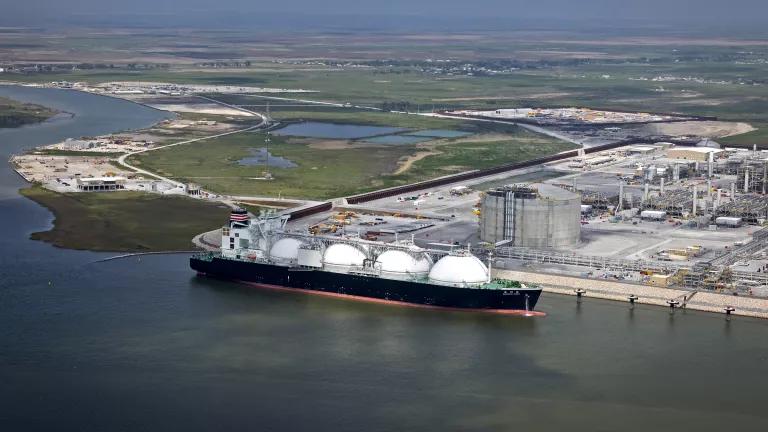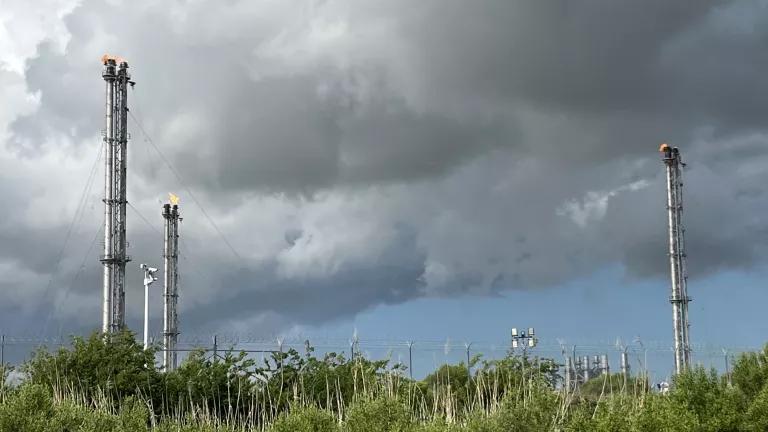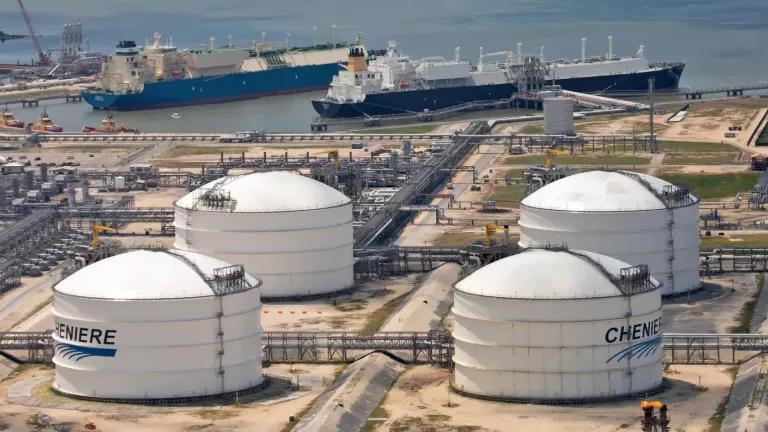NRDC Offers Department of Energy Guidance on LNG Exports
NRDC provides key recommendations that the U.S. Department of Energy should consider as it updates the studies it uses to review LNG export applications.

A liquefied natural gas tanker ship docked at Venture Global’s Calcasieu Pass export facility in Louisiana
Julie Dermansky for NRDC
Thanks to our consultant, Talia Calnek-Sugin, for her work on this advocacy.
Historically, the U.S. Department of Energy (DOE) has essentially rubber-stamped applications to export liquefied natural gas, or LNG. By law, DOE must evaluate whether approving more LNG exports to non-FTA countries is consistent with the American public interest, but its permission has essentially been a foregone conclusion. This changed in January, when the Biden Administration announced that it would pause approvals of new LNG export applications while it updates the underlying environmental and economic analysis it uses to determine whether exports are in the public interest. The agency is taking time to reevaluate the considerations underpinning its cost-benefit analysis of new export terminals.
LNG exports have considerable downsides. As an initial matter, exporting LNG is incredibly energy intensive. In the U.S., LNG comes mainly from fracking methane gas in the Permian basin. Once fracked, manufacturers ship the gas hundreds of miles through pipelines (leaking methane), super-cool it to a liquid state (an energy-intensive process), ship it thousands of miles to overseas markets (using more energy), re-gasify it (using even more energy), ship it hundreds of miles through pipelines again (leaking more methane), only to be combust it (releasing CO2). Methane is a potent fossil fuel, with 80 times the warming potential of CO2.
In addition to worsening the climate crisis, LNG exports affect public health and ecosystems along every step of the supply chain. And shipping all that gas overseas raises cooking, heating, and electricity bills for Americans. It also stymies the global energy transition, potentially slowing the transition to renewables in importing markets, whose investments in LNG import terminals lock them into decades of reliance on fossil fuels.
As fossil fuel executives have made abundantly clear, there can be benefits to LNG exports as well. LNG facilities create some jobs and generate wealth for executives and shareholders. In some cases, LNG might be a lower-carbon substitute for other fossil fuels like coal (although science is increasingly calling that into question). And a certain amount of LNG has important geopolitical and energy security benefits, as the U.S.’ ability to meet Europe’s energy demand in the wake of Russia’s invasion of Ukraine showed.
But until now, DOE’s analysis (last updated in the Trump Administration) has overstated the benefits and underestimated the costs of additional LNG exports. Meanwhile, the U.S. has become the world’s largest LNG exporter and authorized LNG exports have surged to about 40 bcf/day, triple current U.S. LNG exports. This radically different reality requires a radically different assessment of the costs and benefits of additional LNG.
In response, NRDC staff across the international, climate and energy, and policy analysis programs collaborated on a memo to DOE laying out core topics and principles that we believe DOE should consider to robustly update its LNG export review criteria.
NRDC’s key recommendations to DOE are as follows:
Section 1: Climate analysis
- Evaluate LNG export emissions in the context of domestic and global climate goals.
- Develop a consequential life-cycle assessment of the U.S. LNG supply chain, including all stages of production and consumption, as well as the best available science on methane leakage.
- Include a sophisticated analysis of fuel displaced by LNG, including the potential for competition with renewable energy as well as sectoral and geographic nuances.
- Consider the economic impacts of climate change using the social cost of greenhouse gases.
Section 2: Economic analysis
- Analyze the impact of increased LNG exports on US domestic gas prices and price volatility, as well as knock-on effects to domestic industries such as manufacturing and agriculture.
- Incorporate distributional analysis into economic assessments.
Section 3: Analysis of local impacts
- Evaluate local impacts along all steps of the LNG supply chain: exploration and production, transport, liquefaction, shipping, and end use.
- Consider a wide range of local impacts, including those to public health, local economies, ecosystems, and biodiversity.
- Apply the lens of cumulative impacts and environmental justice.
Section 4: National and energy security
- Assess the world’s demand for LNG in the context of global and national climate goals.
- Develop nuanced analysis for key allies’ energy security needs that accounts for climate goals and energy transition plans.
- Reflect the national and energy security implications of climate change.
Section 5: Process
- Strive for transparency and provide opportunities for the public to weigh in throughout the update process. Solicit ongoing feedback from communities directly impacted by LNG exports.
- Apply the findings of this analysis objectively to future export applications and remove barriers to comprehensive export reviews.
DOE can meaningfully improve the permitting process for new LNG exports by incorporating these changes into its analysis and decision-making. For the sake of the climate, communities, and the U.S. economy, it is imperative that DOE get it right.




